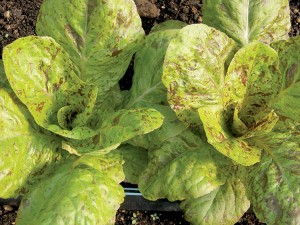By Gretchen Van Benthuysen
Local garden centers have begun stocking flats of lettuce and vegetables that do well in cool weather and taste so delicious when you cut, wash and serve them all within a few minutes.
Four-packs of Red Sail and Iceberg lettuce, escarole, kale, Bright Lights Swiss chard and spinach, for example, could be found at Sickles Market, 1 Harrison Ave, Little Silver and planted in pots by the end of March.
Although they don’t mind cool weather, when the temperature starts flirting with 32 degrees it’s time to cover your plants or risk losing them. With our ever-changing weather these days you’re often wearing boots and the next flip-flops.
In that case you may need to bring pots inside – a garage usually is fine – and cover plants in the ground. A floating row cover is designed to trap heat inside during the day so at night there’s enough warmth to prevent wilted mush. Burpee sells a 72-inch by 50-feet row cover for $20. It also sells the TunLcover which is 18-feet long, consists of a 2-layer UV protected cover with thick gauge wire hoops every two feet that stick into the ground and extends like an accordion.It is designed to act like a greenhouse protecting plants from frost, wind chill and garden pests and sells for $25. Search the internet for more products or visit area garden centers for other options.
If you are really caught off guard, use layers of newspapers or a shower curtain liner weighted down around the edges with rocks, bricks or whatever you can find. Remove the covering during the day when temperatures climb. A sheltered area and southern exposure also are helpful. Besides patience, gardeners need to cultivate a willingness to do what it tales to adapt to the weather.
Lettuces and mixed greens do best in temperatures between 45 and 80 degrees. Once the heat and humidity hit in July plants generally bolt, which means they send up flower stalks to produce seeds and develop a bitter taste. It’s time to pull them up at this point.
But before then, extend your growing season by either harvesting the plants’ outer leaves or cut just above the growing point in the cut-and-come-again method and see new growth emerge for your salad bowl.

Most garden centers buy from suppliers that specialize in mass production and your choices at the local level will be limited. The greens will taste great, but probably you won’t find many heirloom varieties such as Flashy Trout Back. It looks good and tastes great but you have to start it from seed, which is not all that hard to do.
If you grow and harvest lettuce this spring you will want to do it again in the fall, but you won’t be able to find any transplants in the garden centers then. They all are focused on pumpkins and mums after Labor Day.
So take advantage now of materials on sale in stores and online for seed starter kits. Seedlings need two- to three-inches of soil so you can grow them in yogurt or paper cups, but trays are more convenient.
If you plan to start from seed this spring inside — it’s not too late —you will need lights designed for that purpose. It’s the best way to guarantee consistent, abundant light. Set the timer for 15 hours a day and water regularly. Start with the light about two inches above the seeds and raise it as the seedlings grow. If the light is too far away the seedlings will stretch toward it becoming leggy and weak. Let the top of the soil dry out a bit between watering. Soggy is not good.
Do not use just any soil. Seedlings, like babies, are tender and need extra special food — a sterile seed starting mix that will ensure healthy, disease-free seedlings. Jiffy’s Natural & Organic Seed Starting Mix works great. Follow the directions — do not skip the pre-moistened part — and do not, use soil from your garden. You will be doomed to seedling failure.
You will need to use a liquid fertilizer after a couple of weeks. Lettuce loves nitrogen so choose a well-balanced fertilizer with equal parts nitrogen, potassium and phosphate such as 10-10-10 or 5-5-5 mixtures, which all garden centers carry. Ask for help if you are confused.
You could have the somewhat pedestrian garden center varieties with Burpee seedlings — Looseleaf Blend lettuce (Black Seeded Simpson, Lollo Rossa, Red Salad Bowl and Royal Oak Leaf); heirloom Tom Thumb, Four Seasons and Heatwave Blend lettuces; Flashy Trout Back, and A La Carte Spinach under a light inside.
When it’s time to transfer indoor seedlings outside they need to be hardened off. Here’s where a cold frame comes in handy. It also helps extend your growing season. Pampered plants need to be introduced slowly to wind and intense sun. You can also put the plants outside for a few hours at a time, or move to the shade before bringing them back inside for a week or so.
To learn more about spring gardening, the Rutgers Master Gardeners of Monmouth County, 4000 Kozlowski Road, Freehold, are hosting “Celebrate Spring! … a Symposium” from 8:45 to 4 p.m. April 16. Topics include container gardens, spring lawn maintenance, organic vegetable gardening, perennials, butterfly/pollinator gardening, and raised bed gardening. Best of all — it’s free.
To register, or for more information, call 732-303-7614 or visit www.visitmonmouth.com.
More From The Two River Times Home & Garden Special Section
April 14, 2016 Two River Times
- Hummingbird Mania by David Saidnaway
- Prepping For Summer Salads by Gretchen Van Benthuysen
- How to Guarantee Your Garden Starts Off On the Right Foot
- Clippings: Gardening Events Around Town
- Atlantic Highlands Looking for Favorite Trees














